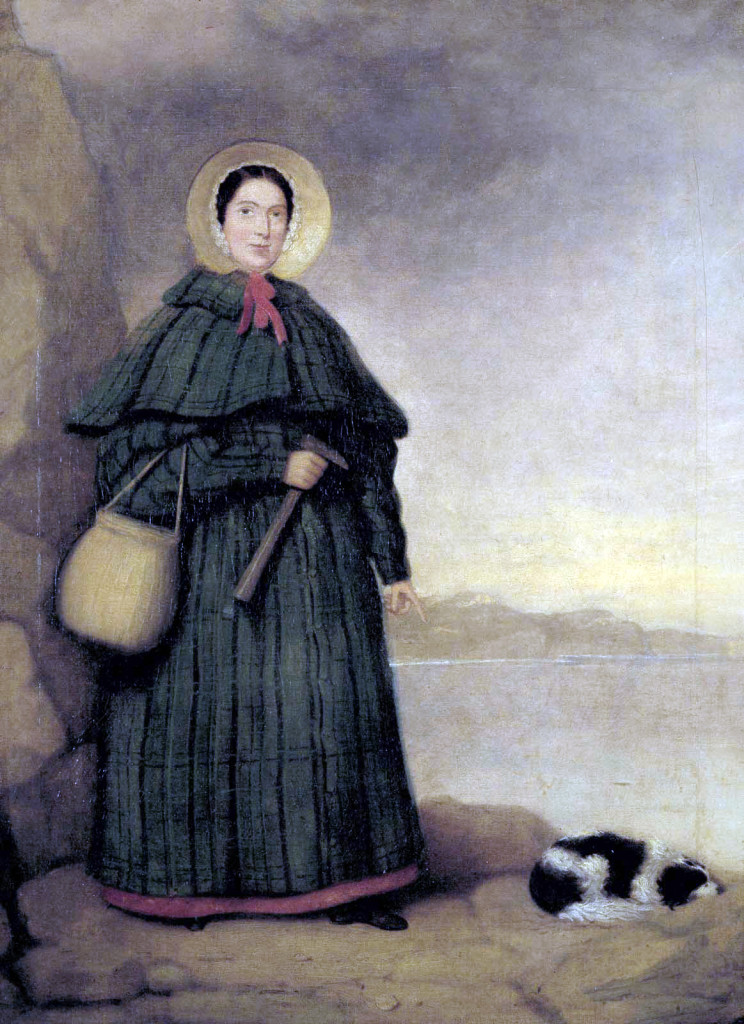
May 21, 1799 – March 9, 1847
Learned to read & write at Congregationalist Sunday school
Field site: Lyme Regis (Dorset, England)
Photograph credit: Portrait of Mary Anning with her dog Tray and the Golden Cap outcrop in the background, Natural History Museum, London. It is credited to “Mr. Grey.” This image was downloaded from Wikimedia Commons.
This month, I am learning that it takes a hell of a lot more time to get even than it does to get mad. Fortunately, it’s also infinitely more satisfying, invigorating, and productive! I’ve had so much fun learning about the research of some pretty amazing scientists. Case in point: I spent twice as long as I should have on Leslea Hlusko’s profile because I could not tear myself away from reading about her baboon studies! And as some of you know, I really, really HATE baboons. I had originally planned to restrict my profiles to living, breathing, active scientists in order to remind myself of the community that surrounds me. However, thanks to an email from Rowan Martindale, I learned that today is Mary Anning’s 215th birthday, and it will be commemorated with a google doodle! So, let’s take a brief look at the woman the Natural History Museum of London calls the greatest fossil hunter ever known and the Royal Society lists as one of the ten most influential British female scientists.
Pretty darned impressive for a person with no formal education.
From an early age, Mary Anning made a living scouring the cliffs of Lyme Regis for Early Jurassic (210-195 Ma) marine fossils and selling them. It was dangerous work; she had to correctly time the tides, navigate steep and slippery shores, and avoid mudflows and landslides. Her beloved dog Tray, constant companion on her fossil hunts (the original field paleontology dog?!), was killed when a cliff collapsed and he was buried in the landslide. The common ammonoids and belemnites earned her a few shillings, and the occasional big find earned a few hundred pounds (upwards of $250K today).
Those big finds helped revolutionize paleontology. Mary Anning discovered complete ichthyosaurs, plesiosaurs, and even a pterosaur. Today, extinction is universally recognized, and pretty much every paleontologist does research that can be somehow tied to extinction. When Mary Anning lived, however, most people supported the biblical record of Earth’s creation and had no means to explain how there could be species from Earth’s past that were not still present. Extinction implies imperfect creation, which was difficult to reconcile with early 1800’s religious doctorine. Through Anning’s careful excavation, preparation, scientific illustration, and anatomical evaluation (all self-taught!), she recognized that the fossils she discovered in the cliffs of Lyme were species no one had ever seen alive. Because she was a woman, and even worse, a working class woman, she was not allowed to publish on her finds, but many of the great geologists and anatomists of her day (Cuvier, Buckland, Owen, and others) published on her specimens, though few acknowledged her as the collector.
Now that you have been (re)introduced toMary Anning, I invite you to check out some of the many resources already published on this ground-breaking field paleontologist. For a straight-up biography, I recommend Dr. Torrens’ 1995 “Presidential Address: Mary Anning (1799-1847) of Lyme; ‘the greatest fossilist the world ever knew'” in the British Journal of the History of Science (v. 28, p. 257-284). Two historical novels that feature Anning, Remarkable Creatures by Tracy Chevalier or Curiosity by Joan Thomas, have also been published in the last 5 years. Additional web resources on Mary Anning include http://www.ucmp.berkeley.edu/history/anning.html and http://www.strangescience.net/anning.htm. For the younger crowd, try http://www.bbc.co.uk/schools/primaryhistory/famouspeople/mary_anning/